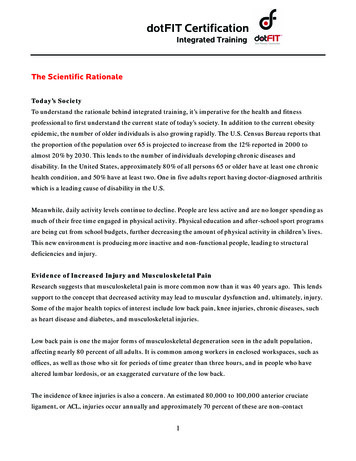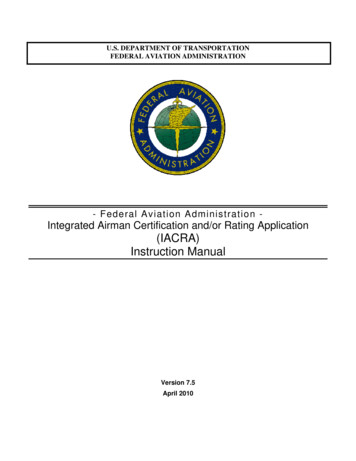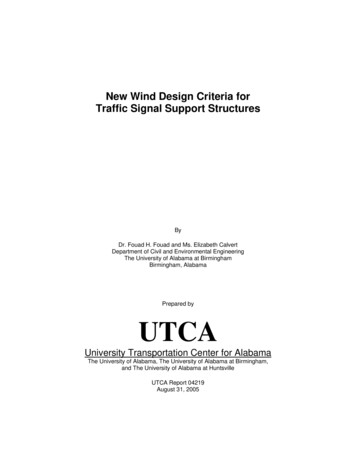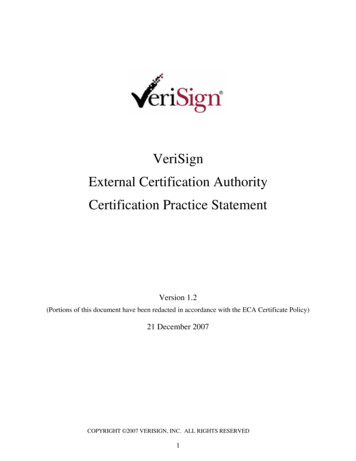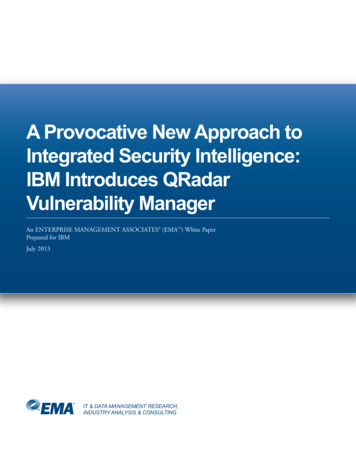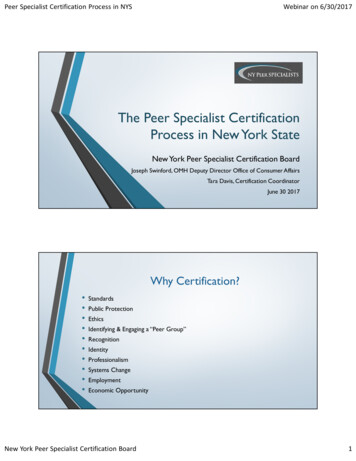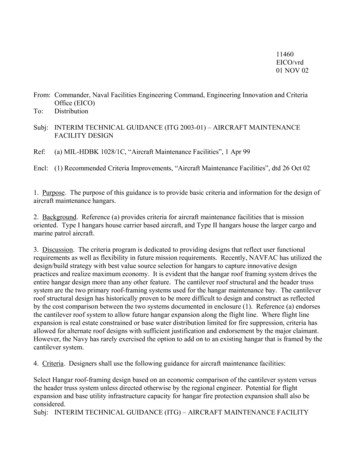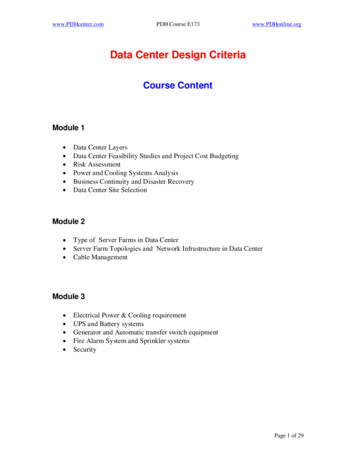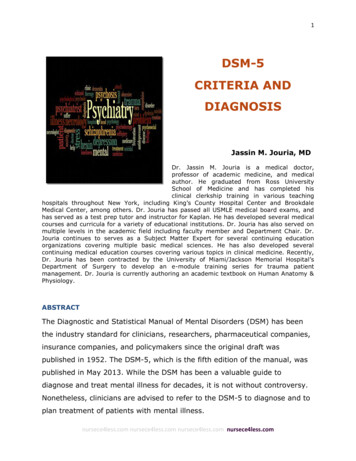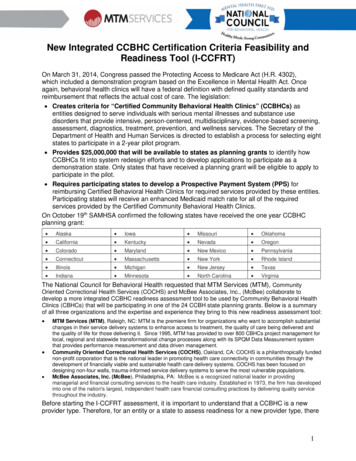
Transcription
New Integrated CCBHC Certification Criteria Feasibility andReadiness Tool (I-CCFRT)On March 31, 2014, Congress passed the Protecting Access to Medicare Act (H.R. 4302),which included a demonstration program based on the Excellence in Mental Health Act. Onceagain, behavioral health clinics will have a federal definition with defined quality standards andreimbursement that reflects the actual cost of care. The legislation: Creates criteria for “Certified Community Behavioral Health Clinics” (CCBHCs) asentities designed to serve individuals with serious mental illnesses and substance usedisorders that provide intensive, person-centered, multidisciplinary, evidence-based screening,assessment, diagnostics, treatment, prevention, and wellness services. The Secretary of theDepartment of Health and Human Services is directed to establish a process for selecting eightstates to participate in a 2-year pilot program. Provides 25,000,000 that will be available to states as planning grants to identify howCCBHCs fit into system redesign efforts and to develop applications to participate as ademonstration state. Only states that have received a planning grant will be eligible to apply toparticipate in the pilot. Requires participating states to develop a Prospective Payment System (PPS) forreimbursing Certified Behavioral Health Clinics for required services provided by these entities.Participating states will receive an enhanced Medicaid match rate for all of the requiredservices provided by the Certified Community Behavioral Health Clinics.On October 19th SAMHSA confirmed the following states have received the one year CCBHCplanning grant: AlaskaCaliforniaColoradoConnecticutIllinoisIndiana IowaKentuckyMarylandMassachusettsMichiganMinnesota MissouriNevadaNew MexicoNew YorkNew JerseyNorth Carolina OklahomaOregonPennsylvaniaRhode IslandTexasVirginiaThe National Council for Behavioral Health requested that MTM Services (MTM), CommunityOriented Correctional Health Services (COCHS) and McBee Associates, Inc., (McBee) collaborate todevelop a more integrated CCBHC readiness assessment tool to be used by Community Behavioral HealthClinics (CBHCs) that will be participating in one of the 24 CCBH state planning grants. Below is a summaryof all three organizations and the expertise and experience they bring to this new readiness assessment tool: MTM Services (MTM), Raleigh, NC: MTM is the premiere firm for organizations who want to accomplish substantialchanges in their service delivery systems to enhance access to treatment, the quality of care being delivered andthe quality of life for those delivering it. Since 1995, MTM has provided to over 800 CBHCs project management forlocal, regional and statewide transformational change processes along with its SPQM Data Measurement systemthat provides performance measurement and data driven management.Community Oriented Correctional Health Services (COCHS), Oakland, CA: COCHS is a philanthropically fundednon-profit corporation that is the national leader in promoting health care connectivity in communities through thedevelopment of financially viable and sustainable health care delivery systems. COCHS has been focused ondesigning non-four walls, trauma-informed service delivery systems to serve the most vulnerable populations.McBee Associates, Inc. (McBee), Philadelphia, PA: McBee is a recognized national leader in providingmanagerial and financial consulting services to the health care industry. Established in 1973, the firm has developedinto one of the nation's largest, independent health care financial consulting practices by delivering quality servicethroughout the industry.Before starting the I-CCFRT assessment, it is important to understand that a CCBHC is a newprovider type. Therefore, for an entity or a state to assess readiness for a new provider type, there1
are specific comprehensive requirements that must be understood and incorporated into theresponses to the I-CCFRT assessment as outlined below:1. CCBHCs have a distinct service delivery model – trauma-informed recovery outside thetraditional four walls of a historical community behavioral health center;2. CCBHCs have a new Prospective Payment System (PPS) payment methodology (particularlyin reference to PPS-2 rate setting states);3. CCBHCs have a requirement to have meta-data that is tied to the definition of the provider type(not necessarily tied to the historical “four walls” delivery systems); and4. CCBHCs have a requirement to contract with other organizations or with a DesignatedCollaborating Organization (DCO) and the CCBHC has specific compliance responsibility forthe other organizations and DCOs. (I.e., the CCBHC’s compliance responsibility is juxtaposedwith whether the contractual organization is “related” or “unrelated” as defined under Medicaidrules. Therefore, the entity may need to be a DCO for a CCBHC rather than being a CCBHC.)To address these important new provider type requirements, the I-CCFRT contains specificsections as follows:Assessment of Feasibility to become a CCBHC: Below is an outline of the section number topicareas in the I-CCFRT:1. Feasibility Sections: The purpose of Sections A - E is for your clinic to consider whether ornot it is feasible for the clinic to move forward to become a CCBHC or whether your clinicshould consider becoming a DCO for a CCBHC:Non Four Walls Design Model and how you can objectively measure if the servicedelivery culture will work in the new systemB. Trauma-Informed Care Model and objective indicators of the ability to deliver this type ofcareC. PPS Rate Setting Support RequirementsD. Other Considerations Related to CCBHC Feasibility and Readiness:1. Know the State Medicaid Rules2. Understand How Your Relationships Translate into Costs3. Getting Technology Right4. Telemedicine5. Clinical Quality Assurance6. Corporate Practice of Medicine7. PPS-2--Another Level of ComplicationE. CCBHC Service Delivery Operational Requirements2. Readiness Sections: If your clinic has determined that it is feasible to move forward as aCCBHC, Sections E and F support a readiness assessment of your clinic’s ability to meet theCCBHC certification standards and assess the ability of your management team to supporttimely and effective transformational systems change:E. Compliance with CCBHC Certification RequirementsF. Decision-Making and Change Management Support AssessmentA.The I-CCFRT provides a system for gauging the level of concern among your staff that will supportawareness of the level of change management that may be needed to support enhanced servicedelivery processes, staffing, scope of services, quality outcomes, reporting and governance areas.The readiness tool also provides a sub-total section and overall concern level score which cansupport more objective identification of change management needs for the clinic to meet allcriteria.2
Important Definitions: Before completing the I-CCFRT, it is important to review andunderstand “Definitions” of important terms used in the criteria. The SAMHSA providedCCBHC criteria terms and identified definitions as well as a summary of the qualitymeasures and other reporting requirements are listed beginning on page 34 whichfollows at the end of I-CCFRT Assessment Scoring Sheet.Use of I-CCFRTThe I-CCFRT is a self-assessment tool that will require your management team to schedulejoint time to meet and work through the six programs. The typical time frame to complete theassessment will vary from team to team based on the service delivery processmeasurement and support awareness that your team processes.Below is important context for your management team as preparation for your use of the ICCFRT:1. It is important for your team to move away from anecdotal responses to the certificationcriteria questions such as “We should be able to provide this support and/or meet thecriteria .” to understand the reality of the actual capacity of the clinic and/or individuallocations/programs to actually implement the design plan, operational requirements andmeet the criteria.2. If there are significant variances in response levels or service process data among themanagement team members, it is important to identify if an I-CCFRT needs to be completedfor specific programs (i.e., children/adolescent vs. adult, etc.) or locations in order to fullyidentify process variances within the clinic. If it is determined best to use multiple I-CCFRTforms to assess programs/locations within the clinic, please add together and average thequestion and section scores to generate an overall score for the clinic.3. If the question and section scores have more than a one point variance, the key issue toidentify is to determine if your clinic is operating as a “group practice” or a “loosely heldfederation of individual practices”.NOTE: If your clinic finds that there are significant practice variances within specificprograms and/or locations, then overall clinic compliance with the required certificationcriteria can be significantly more difficult. Therefore, an important outcome of the I-CCFRTmight be to identify specific internal practice variances and how to reduce/eliminate thesevariances.4. The self assessment scoring model for each question and section of the I-CCFRT is basedon a five point scale as outlined below:12345Serious ChallengeQuite a bit of ConcernModerate ConcernSmall ConcernNot A ChallengeThe level of concern that your team identifies needs to be supported by the following scoringparameters:a. If a particular design, operational and/or certification criterion focuses on the state’s ability toperform, please rate your level of concern about your CCBHC providing the state necessaryinformation to support the state performance requirement.b. If your team is not able to identify the specific response requested to any primary question,the level of challenge score should be documented as a “1”.3
c. Most assessment questions contain a “Yes” or “No” identifier prior to the concern rating. Thefocus for this question is for your team to confirm if the identified design, operationalrequirement and/or criterion is current practice within your clinic - YES or NO. If your teamresponds “NO”, the specific criterion concern response should be a 1 – 4 based on the levelof concern you have about developing the capacity to be compliant with the criterion. Also, ifyour team identifies a “Yes” and does not feel that a “5” fully identifies the appropriateresponse, please identify the level of concern that your teams has about being fullycompliant.d. If your team identifies a level of practice variance within various programs or locations, thescore should be a “2” or “3” based on the level of variance identified and the amount of effortit will take to reduce the variance to a standardized clinic wide practice.At end of each section of the I-CCFRT, there is a “Total Cumulative Score” indicator that will allowyour team to total all individual question scores in that section. Also, at the end of the I-CCFRT,there is a scoring sheet that provides for transferring the section cumulative scores to an overall scoresummary with recommendations for next steps.E-Form Instructions: The I-CCFRT assessment is provided as an e-form. On the following pages, please tabthrough the assessment sections or click on a specific response area and enter the text or click on a checkeditem. Using the tab key will advance the pages.4
I-CCFRT - Assessment of Feasibility and Readiness to Become a CCBHCClinic Name:Primary Contact Person :E-mail:Feasibility Assessment Sections A - ESection A: Non-Four-Walls System Design Readiness Assessment:Context for Non-Four-Walls System Design Section:For a CCBHC to effectively address health care disparities, the traditional four-wall approach to health care delivery must bereconsidered because many individuals with the highest needs often: Cannot come to an on-site facility to receive the care they need; Require novel methods of care to integrate behavioral and physical health and appropriately manage care; and Require interventions that include community involvement and education—particularly individuals with substance use disorder.As states think through the quality metrics and evidence-based practices included in the CCBHC program, incorporating the TripleAim (individual health, population health, and controlling costs) and defining the role of a CCBHC in addressing population healthis an integral part of a non-four-walls Trauma-Informed Recovery Model.1.CCBHCs must adapt to the behavioral health needs of diverse communities and decrease health care disparities. Can yourfacility:a. Reach individuals with behavioral health needs in diverse settings such as:o Jails and prisons,o Foster families,Yeso Schools,o Shelters,Noo Churches,o Emergency Rooms, ando Homes,o Public parks and recreational facilities;1Serious Challengeb.1112Quite a bit of Concern3Moderate ConcernYes4Small Concern2Quite a bit of Concern3Moderate Concern5Not A ChallengeYes4Small Concern2Quite a bit of Concern3Moderate ConcernNo5Not A ChallengeYes4Small ConcernNoNo5Not A ChallengeHealth care providers have come to understand that health care is best delivered through what public healthprofessionals call the Triple Aim: individual health, population health, and controlling costs. All three parts of theTriple Aim must be tackled at the same time—otherwise; the optimal outcomes will remain elusive. Is yourclinic currently conceptualizing its service delivery in terms of the Triple Aim?1Serious Challenge4.5Not A ChallengeOngoing cycles of victimization and trauma create vocabularies that often are foreign to many healthcare service providers. Is your staff and facility culturally competent to interpret and understand thevocabulary of victimization and trauma?Serious Challenge3.4Small ConcernIntegrate the non-four-wall services into the core of CCBHC in a way that is culturally competentand reflects a trauma-informed recovery model?Serious Challenge2.3Moderate ConcernAddress the needs of culturally diverse individuals with culturally competent providers, staff, andpeer support?Serious Challengec.2Quite a bit of Concern2Quite a bit of Concern3Moderate Concern4YesNo5Small ConcernNot A ChallengeAs a CCBHC engages with individuals who are trapped in the cycle of victimization and trauma, successfulYesoutcome will be dependent upon the CCBHC’s ability to engage with the community from which theseindividuals come and address the root causes of this cycle. Does your clinic currently have this capability?1Serious Challenge2Quite a bit of ConcernNote: Total Score for this section ranges from 6 to 303Moderate Concern4Small ConcernNo5Not A ChallengeSection A Total Cumulative Score:Section B: Trauma-Informed Care Readiness Assessment:Overview of Trauma-informed care: A trauma-informed approach to care “realizes the widespread impact of traumaand understands potential paths for recovery; recognizes the signs and symptoms of trauma in clients, families, staff,5
and others involved in the system; and responds by fully integrating knowledge about trauma into policies, procedures,and practices, and seeks to actively resist re-traumatization.” The six key principles of a trauma-informed approachinclude: safety; trustworthiness and transparency; peer support; collaboration and mutuality; empowerment, voice andchoice; and cultural, historical and gender issues (Substance Abuse and Mental Health Services Administration [2014]).Trauma-Informed Care is Community-Based Care (Non-Four Walls):In most parts of the country the predominant model of care delivery is predicated on consumers accessing care at aclinic with occasional visits in the community. The CCBHC criteria state clearly that all services are available without“4-wall” constraints – meaning that they can be delivered anywhere in the community or via tele-health and still beconsidered a valid encounter. Further, the care coordination requirements in the statute and subsequent criteriarequire the CCBHC to have care coordination relationships with a broad range of entities, including community andpsychiatric hospitals, juvenile and criminal justice facilities, child welfare, as well as specialty substance usetreatment, primary care and other social service agencies.CCBHCs are paid an all-inclusive rate that is based on costs. This payment flexibility coupled with the carecoordination requirements and the emphasis on community-based care provides the CCBHC with a tremendousamount of flexibility in terms of where and how they deliver care. Consider the following opportunities to improve care:Emergency room diversionJail Booking diversionPost-release “warm hand-off”Foster care placement supportCCBHCs have an obligation and the payment flexibility to intervene in each of these settings, facilitating access tocare, supporting healthy transitions, and avoiding more expensive levels of care.1.1Serious Challenge2.11Moderate Concern4Small ConcernNo5Not A Challenge2Quite a bit of Concern3Moderate Concern4Small ConcernYesNo5Not A Challenge2Quite a bit of Concern3Moderate Concern4Small ConcernYesNo5Not A ChallengeOrganizations that are trauma informed are inherently recovery oriented and vice versa. Does your cliniccurrently incorporate the following principles of a trauma-informed organization/system into its clinicalphilosophy: Safety Trustworthiness and transparency Historical, cultural, gender issues Mutuality and collaboration Empowerment Voice and Choice1Serious Challenge5.Quite a bit of Concern3Within the bounds of state licensure and certification regulations, CCBHC staffing will include Medicaidenrolled providers who adequately address the needs of the consumer population served. Credentialed,certified, and licensed professionals with adequate training in person-centered, family-centered, traumainformed, culturally competent and recovery-oriented care will help ensure this objective is attained. Caremeeting these standards will further help the CCBHCs achieve integrated and high quality care. Is your cliniccurrently able to meet this service delivery model requirement?Serious Challenge4.2An important indicator of a trauma-informed service delivery culture is to shift from a primary reliance on“scheduling clients” as a solution to meeting their service delivery needs, to a clinical culture of actually“seeing clients” by using all of the then currently available clinical service capacity available at that time. Doesyour clinic have a clinical approach that is primarily focused on “seeing clients “?Serious Challenge3.YesBased on the above definition, does your clinic currently have the service delivery culture and capacity todeliver non-four walls community-based trauma informed care?2Quite a bit of Concern3Moderate Concern4Small ConcernYesNo5Not A ChallengeDoes your clinic currently have the capacity to deliver the key elements of a non-four-wall, trauma-informed care deliverysystem as outlined below?a. Comprehensive early screening and assessment for trauma that is sensitively delivered?YesNo1Serious Challenge2Quite a bit of Concern3Moderate Concern4Small Concern5Not A Challenge6
b.Consumer involvement to lend voice, choice and advocacy for persons served?1Serious Challengec.1Serious Challenge112Quite a bit of Concern3Moderate ConcernYes4Small Concern2Quite a bit of Concern3Moderate Concern2Quite a bit of Concern3Moderate Concern2Quite a bit of Concern3Moderate Concern12Quite a bit of Concern3Moderate ConcernNo5Not A ChallengeYes4Small ConcernNot A ChallengeYes4Small Concern5YesNo5Not A ChallengeYes4Small ConcernNoNot A Challenge4Small ConcernNo5Using data to inform quality improvement, develop outcome measures and monitor the everchanging nature of the culture within the organization?Serious Challenge6.Not A ChallengeCreating trauma-informed community partnerships to reach across systems in order to ensure thatall services provided
programs and/or locations, then overall clinic compliance with the required certification criteria can be significantly more difficult. Therefore, an important outcome of the I-CCFRT might be to identify specific internal practice variances and how to reduce/eliminate these variances. 4.


